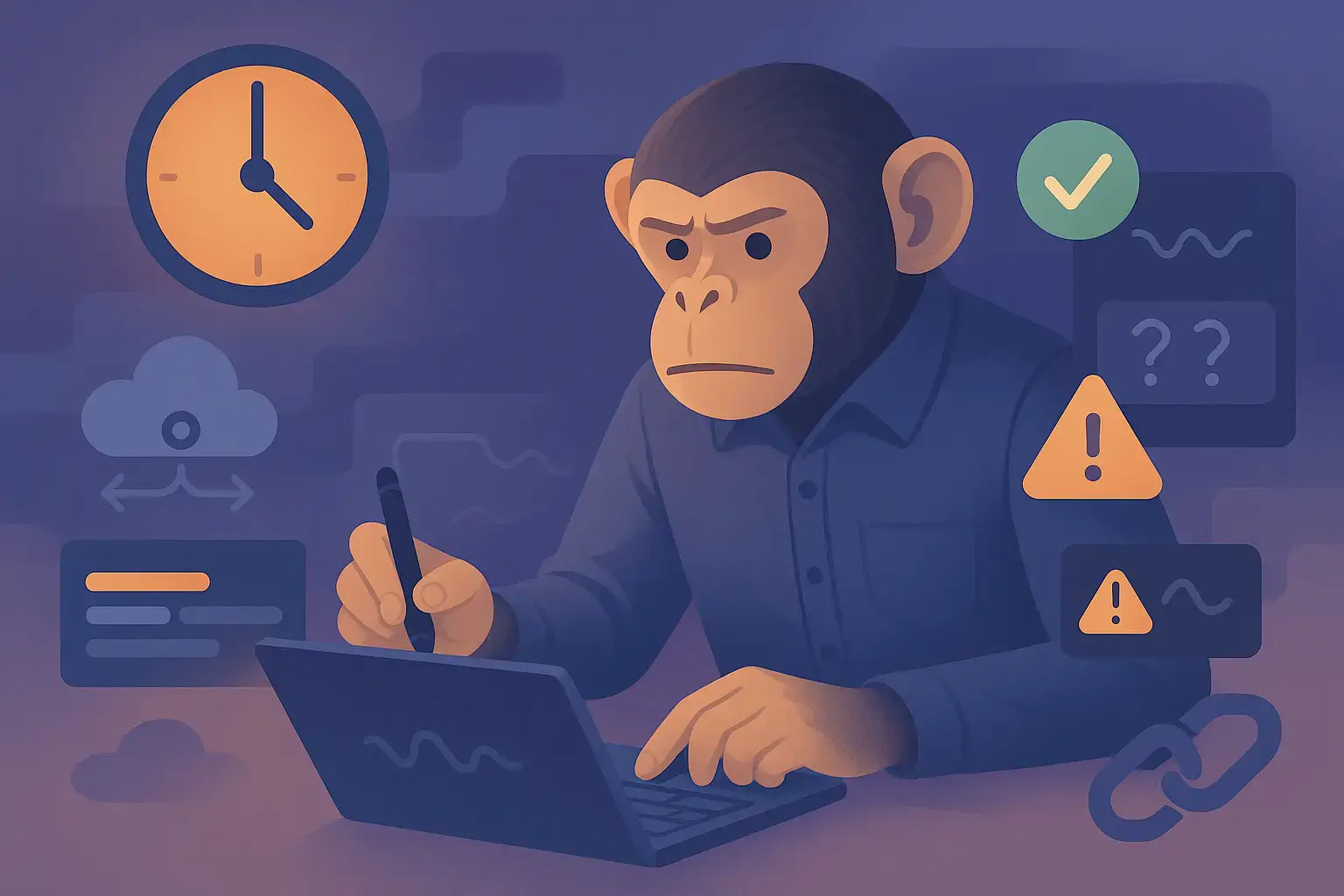In this guide, we’ll break down everything you need to know about monkey testing in software testing: what it is, how it works, when to use it, and how it fits into your broader testing strategy. Let’s start.
What is Monkey Testing?
Monkey testing is a software testing technique that uses random inputs, clicks, swipes, and other interactions to check if an application crashes or behaves unexpectedly. The name comes from the idea that it’s like letting a monkey loose on a keyboard – random, unpredictable, and potentially chaotic.
Unlike scripted testing approaches, where each test case follows a specific path, monkey testing embraces chaos. It sends random inputs at various frequencies to your system (application, website, etc), hitting buttons, entering data, and going through screens without any predetermined plan. The goal is to catch bugs that more structured testing approaches might miss.
It is like a QA equivalent of stress-testing a chair by having different-sized people sit on it in various ways rather than just applying a calculated amount of weight in specific spots. It’s messy, but it’s effective at finding real-world breaking points.
Monkey testing means using randomised inputs to test the stability and reliability of software applications. This approach is particularly valuable for finding:
- Memory leaks
- Race conditions
- Unexpected crashes
- UI responsiveness issues
- Boundary condition bugs
- Stability problems under random use patterns
In essence, monkey testing software helps answer the question: “What happens when users do things we never expected them to do?”
The Infinite Monkey Theorem
The name “monkey testing” draws inspiration from the famous “Infinite Monkey Theorem” – a thought experiment suggesting that a monkey hitting keys randomly on a typewriter for an infinite amount of time will eventually type out the complete works of Shakespeare. Sounds bizarre, but not impossible in the grand scheme of things.
In the context of software monkey testing, this theorem takes on a practical meaning: if you perform enough random testing operations on your software, you’ll eventually trigger every possible scenario, including the edge cases and rare conditions that cause bugs.
Let’s say your typical user follows expected paths maybe 95% of the time. But what about those unpredictable 5% of interactions? Those might be where your most catastrophic bugs hide.
Randomness, when applied strategically and in sufficient quantity, can be more effective at finding certain types of bugs than carefully designed test cases. It’s like how natural evolution tests countless random genetic variations to find what works, except we’re using this randomness to find what breaks.
Of course, we don’t have infinite monkeys (or time), which is why modern monkey testing is often automated and strategically focused. We’re not looking to recreate Shakespeare – we’re looking to crash your app before your users do.
Monkey Testing can be categorised into two types:
Gorilla Testing - This approach involves a focused and intensive execution of certain functionalities of the application. It is akin to a monkey’s singular focus on a particular task, scrutinising specific areas that are deemed critical.
Random Monkey Testing - As the name suggests, this is a more chaotic form of testing that does not prioritise any functionality. Testers perform random actions to gauge the application’s overall resilience and stability.
Objectives of a Monkey Test?
Monkey testing reveals the uncomfortable truth: your application might work perfectly in demos but fall apart when real users get their hands on it.
So your structured test cases follow logical paths that make sense to developers and testers. But actual users? They click randomly, mash buttons, enter weird data, and use your app in ways you never imagined. They’re essentially performing monkey tests without realising it, and when things break, they’re not going to file neat bug reports with reproduction steps.
Monkey testing solves this problem by intentionally subjecting your application to the kind of chaotic, unpredictable usage it will face in the real world. It’s like stress-testing your assumptions about how robust your application really is:
- Find stability issues – Discover crashes, freezes, and memory leaks that occur under random usage pattern
- Identify UI responsiveness problems – Detect interfaces that become unresponsive under unusual input sequence
- Uncover hidden bugs – Reveal defects that structured testing missed due to unexpected input combinations
- Stress test performance – Push the application to its limits with rapid-fire random interactions
- Validate error handling – Ensure the application gracefully handles unexpected inputs without critical failures
- Discover security vulnerabilities – Random inputs sometimes trigger security issues by hitting unprotected paths
- Challenge assumptions – Test whether developer assumptions about user behaviour hold up under chaotic conditions
- Ensure data integrity – Verify that random interactions don’t corrupt application data
- Test recovery mechanisms – Confirm that applications can recover from unusual states triggered by random inputs
While monkey testing excels at discovering unexpected issues, managing and tracking all these random findings quickly becomes overwhelming without proper organisation. This is where a robust test management system becomes essential.

Aqua cloud, an all-around Test Management System (TMS) takes this responsibility perfectly. It provides you with a centralised repository where you can combine all your manual and automated tests, no matter how chaotic they look. With aqua’s AI, you can generate test cases, test data, and requirements within three clicks, saving up to 98% of your time compared to manual approaches. Automation integrations like Selenium, Jenkins, Ranorex allow you to speed up your CI/CD pipelines, while Jira and Azure DevOps integrations helps you combine two different worlds in perfect sync. Capture, one-click bug recording integration, is exactly what you need to record the bugs you captured during monkey or any other testing. Ready to streamline it all?
Get a 100% centralised repository for all your tests, including monkey
Who should perform monkey testing?
Here’s the thing about monkey testing – it’s one of those techniques that seems simple until you realise how many different perspectives can make it more effective.
You might think monkey testing is just about letting chaos loose on your application, but the reality is more nuanced.
Different team members bring unique insights that can transform random testing from basic chaos into strategic quality assurance. A developer running monkey tests will notice different patterns than a security professional, and a UX designer will interpret the results through a completely different lens.
The most successful monkey testing happens when multiple roles get involved, each contributing their expertise to make the chaos more meaningful:
• QA testers – They have the testing mindset needed to interpret random test results effectively
• Automation engineers – They can set up sophisticated random testing frameworks for continuous testing
• Developers – They can run quick monkey tests during development to catch obvious stability issues early
• DevOps team members – They can include monkey testing into CI/CD pipelines for ongoing quality checks
• UI/UX designers – They gain insights into unexpected user interactions that might affect design decisions
• Performance engineers – They can use monkey testing to find performance bottlenecks under random loads
• Security professionals – They can use random testing to discover potential security vulnerabilities
• Product managers – They should understand monkey testing results to prioritise stability improvements
• New team members – Monkey testing provides them with a broad exploration of the application behaviour
Types of Monkey Testing
Monkey testing comes in several flavours, each with different levels of intelligence and purpose. Understanding these types helps you choose the right approach for your testing needs.
Dumb Monkey Testing
This is the most basic form of monkey testing, living up to its name with completely random inputs with no awareness of the application’s state or structure.
• Generates completely random inputs without any knowledge of application
• Doesn’t validate results or analyse the consequences of actions
• Uses pure randomness for clicks, taps, swipes, and data entry
• Often produces many false positives (apparent bugs that aren’t real issues)
• Good for basic crash testing, but inefficient for complex applications
• Typically runs for long periods to compensate for a lack of intelligence
- Example: Random clicking on a screen without any pattern or purpose
Smart Monkey Testing
Taking a step up in sophistication, smart monkey testing incorporates some awareness of the application structure and state.
• Has basic knowledge of the application’s UI elements and structure
• Understands which inputs are valid for different controls (numbers in number fields, etc.)
• Can follow simple sequences or workflows while still maintaining randomness
• Recognises application states to avoid getting stuck in loops
• Produces fewer false positives than dumb monkey testing
• Can focus testing efforts on specific application areas or features
- Example: Randomly testing a form, but only entering valid data formats in each field
Brilliant Monkey Testing
The most advanced form of monkey testing combines randomness with a sophisticated understanding of the application.
• Possesses deep knowledge of application architecture and business logic
• Creates test scenarios that combine random elements with logical workflows
• Monitors application state and adjusts testing strategy accordingly
• Can identify and report potential issues beyond just crashes
• Uses statistical models to focus on high-risk areas of the application
• Often incorporates machine learning to improve testing efficiency over time
- Example: Intelligently testing an e-commerce checkout flow with random product selections but valid payment information
Choosing the right type depends on your testing goals, available resources, and the complexity of your application. Many testing strategies use a combination of all three types at different stages of development.
Features of Monkey Testing
While your team spends hours crafting detailed test cases, monkey testing can run thousands of unpredictable scenarios overnight without breaking a sweat. It’s the testing approach that works harder when you’re not watching, finding those weird edge cases that would take months to discover manually.
Here’s what gives monkey testing its unique testing power:
- Randomness – Uses unpredictable input patterns to find unexpected issues
- No scripting required – No need to write detailed test cases before execution
- Automation-friendly – Easily automated for continuous testing without human intervention
- High coverage potential – Can potentially execute rare user paths that manual testing might miss
- Scalability – Can run for hours or days, generating thousands of test scenarios
- Tool-supported – Many frameworks and tools are available for different platforms and application types
- Platform-agnostic – Applicable to mobile, web, desktop, and IoT applications
- Configurable intensity – Adjustable frequency and complexity of random actions
- Reproducibility options – Modern monkey testing tools can record and replay specific issues
- Resource efficiency – Once set up, it requires minimal ongoing human resources
- Complementary approach – Works alongside traditional testing methods for comprehensive quality assurance
These features make monkey testing a unique and valuable addition to any comprehensive testing strategy.
Importance of Monkey Testing
Monkey testing plays a crucial role in modern software quality assurance that goes beyond what conventional testing can achieve.
First, it catches the unexpected. Your carefully designed test cases follow logical paths and expected user behaviours. But real users are unpredictable, and monkey testing simulates this unpredictability. It finds bugs that emerge only when the application is used in ways nobody thought to test.
Monkey testing also excels at finding stability issues. By making your application vulnerable to rapid, random inputs for extended periods, you reveal memory leaks, resource consumption problems, and fragile components that might otherwise only surface after days or weeks of real-world usage.
For mobile apps, it’s particularly valuable. Battery drain, performance degradation, and crashes often only appear under sustained random usage. Monkey testing can simulate hours of erratic user behaviour in minutes, catching these issues before release.
Security vulnerabilities sometimes hide in unexpected corners of your application. Random testing occasionally strikes gold by triggering input validation failures or unexpected state combinations that more methodical approaches might miss.
Perhaps most importantly, monkey testing challenges your assumptions. Developers and testers carry biases about how users will interact with our software. Monkey testing has no such biases, it will try combinations and sequences you’d never consider and reveal blind spots in your testing approach.
Where Can We Use Monkey Testing?
Monkey testing shines in several specific testing contexts where unpredictability and stress-testing are valuable. Let’s explore where this technique delivers the most value:
Mobile Applications
Mobile apps are prime candidates for monkey testing. Users interact with mobile interfaces in wildly varied ways, including rapid tapping, erratic swipes, switching between apps, and responding to interruptions like calls or notifications. The Android UI/Application Exerciser Monkey tool is specifically designed for this purpose, generating pseudo-random streams of user events to stress-test Android applications.
For example, a banking app might work perfectly in manual testing but crash when a user rapidly switches between transfer screens while receiving push notifications – a scenario that monkey testing example that could easily uncover critical issues.
Gaming Applications
Games involve complex interactions and state changes that are nearly impossible to cover completely with scripted tests. Players will try unexpected combinations of actions, especially in open-world or sandbox games.
A game testing team at a major studio can discover a critical bug where rapidly switching weapons while jumping and using a special ability simultaneously causes characters to clip through walls. It is something their structured testing never would uncover and would make the game a laughing stock in the relentless gaming community.
Web Applications
Modern web applications have complex UI interactions and state management. Monkey testing can reveal issues with event handling, race conditions in asynchronous operations, and memory leaks during extended sessions.
An e-commerce site might appear stable under normal testing but develop memory leaks that only surface after a user has rapidly browsed dozens of product pages with various filtering options. It is exactly the kind of scenario monkey testing excels at finding.
IoT and Embedded Systems
IoT devices often operate in unpredictable environments with varied usage patterns. Monkey testing helps ensure these systems remain stable under unexpected input sequences.
A smart home system might work perfectly during scripted testing but fail when receiving a rapid sequence of contradictory commands from multiple users – a scenario easily simulated with monkey testing.
Mature Products Needing Regression Testing
For established products with large codebases, monkey testing provides an efficient way to detect regressions without maintaining thousands of test cases.
For example, Microsoft used monkey testing extensively on Windows to ensure new updates didn’t break compatibility with existing applications, running millions of random input sequences against both the operating system and applications.
Monkey Testing vs. Other Testing Methods
Understanding how monkey testing compares to related approaches helps you use the right tool for each testing challenge:
| Testing Method | Primary Focus | Structure Level | Test Case Design | Best For |
|---|---|---|---|---|
| Monkey Testing | Random inputs and interactions | Low to medium | Unscripted random generation | Finding unexpected crashes, memory issues |
| Gorilla Testing | Focused heavy-load testing on specific features | High | Targeted aggressive testing | Finding breaking points in critical features |
| Ad-hoc Testing | Exploratory testing based on tester’s intuition | Low | Unscripted but human-guided | Finding obvious bugs quickly without formal planning |
| Fuzz Testing | Invalid, unexpected inputs | Medium | Semi-structured invalid data generation | Finding security vulnerabilities and input handling issues |
| Exploratory Testing | Human-guided investigation | Medium | Unscripted but purposeful | Finding usability issues and logical bugs |
| Regression Testing | Ensuring existing features still work | High | Carefully structured test cases | Verifying changes don’t break existing functionality |
| Load Testing | System behaviour under heavy usage | High | Structured performance scenarios | Finding performance bottlenecks under predictable loads |
| Chaos Testing | System resilience | Medium | Structured infrastructure failures | Finding weaknesses in distributed systems |
The key distinction is that monkey testing embraces pure randomness, while most other methods maintain some level of structure or focus. This makes it uniquely valuable for finding issues that occur only under unexpected or chaotic conditions.
Advantages and Disadvantages of Monkey Testing
Like most powerful testing techniques, monkey testing comes with a classic trade-off: it’s incredibly good at finding surprises, but terrible at finding what you’re specifically looking for.
This isn’t a flaw, it’s the fundamental nature of chaos-based testing. The same randomness that helps monkey testing discover bizarre edge cases also makes it frustratingly unpredictable when you need systematic validation. Understanding these strengths and limitations is crucial for using monkey testing effectively rather than expecting it to solve every testing challenge.
Here’s how monkey testing’s superpowers can also become its kryptonite:
Advantages
- Discovers unexpected bugs – Reveals issues that structured testing might never encounter
- No scripting overhead – Doesn’t require writing and maintaining test cases
- Efficient resource usage – Once configured, it runs with minimal human supervision
- Broad coverage – Tests countless paths through the application
- Unbiased approach – Not limited by tester assumptions about user behaviour
- Finds stability issues – Excellent at uncovering memory leaks and resource problems
- Works across platforms – Applicable to virtually any interactive software
- Easy to scale – Can generate thousands or millions of test interactions
- Cost-effective – High ROI for bug discovery relative tothe effort required
- Complements other testing – Finds different issues than structured testing approaches
Disadvantages
- Limited bug reproduction – Can be difficult to reproduce issues found during testing
- High false positive rate – May report “bugs” that are actually invalid usage patterns
- Poor for functional verification – Doesn’t methodically verify that features work correctly
- Challenging result analysis – Requires skill to interpret test results meaningfully
- Inefficient for targeted testing – Not suited for testing specific features systematically
- Can miss obvious bugs – Might not hit common use cases in reasonable time frames
- Tool dependency – Effectiveness often relies on the quality of monkey testing tools
- Difficult success measurement – Hard to determine when testing is “complete”
- Can be resource-intensive – Long-running tests may use significant computing resources
- Not suitable for critical path validation – Too unpredictable for validating essential workflows
Best Practices for Monkey Testing
To get the most value from monkey testing while avoiding its disadvantages, follow these proven practices:
Use a Stable Testing Environment
Run monkey tests in isolated environments that won’t affect production systems. Ensure your test environment closely mirrors production but can be easily reset after destructive testing.
Start with a Known Good State
Always begin monkey testing from a clean, known application state. This makes it easier to identify whether issues encountered are due to the current test session or pre-existing problems.
Configure Test Intensity Appropriately
Adjust the speed and complexity of random interactions based on your application. Some applications need rapid-fire events to reveal issues, while others need more deliberate, slower interactions to expose bugs.
Record Test Sessions
Always record monkey testing sessions so you can replay the exact sequence of events that led to any discovered issues. Modern tools like Capture offer recording capabilities that make reproducing bugs much easier.
Combine with Monitoring Tools
Integrate performance and resource monitoring tools with your monkey testing to catch memory leaks, CPU spikes, and other resource issues that might not cause immediate crashes but indicate problems.
Implement Reasonable Timeouts
Set appropriate timeouts for your monkey testing sessions. Some issues only emerge after extended testing periods, but endless tests with no time limits can waste resources.
Use Seed Values for Reproducibility
Use random number generator seeds when available in your monkey testing tools. This allows you to reproduce the exact same sequence of random events when needed to verify bug fixes.
Balance Monkey Types
Don’t rely solely on one type of monkey testing. Combine dumb monkey testing for broad coverage with smart or brilliant monkey tests for more focused areas of concern.
Integrate into CI/CD Pipelines
Automate monkey testing as part of your continuous integration process to catch stability issues early. Consider running shorter monkey tests on every build and more extended sessions nightly.
Best tools for Monkey Testing
Choosing the right monkey testing tool can make the difference between useful chaos and just plain chaos. The best tools balance randomness with configurability, letting you unleash controlled mayhem that actually helps improve your application’s resilience:
- Android Monkey – The official UI/Application Exerciser Monkey tool built into the Android SDK
- Appium – Open-source automation framework supporting monkey-style testing for mobile apps
- Chaos Monkey – Netflix’s tool for testing system resilience by randomly terminating services
- Gremlins.js – JavaScript library for monkey testing web applications
- Monkey Test It – Online service for quick website testing without installation
- UI Automator – Google’s UI testing framework that supports random testing patterns
But here’s the challenge with monkey testing tools: they’re excellent at creating chaos, but terrible at helping you make sense of what they find. You might discover dozens of random crashes, weird UI glitches, and unexpected behaviours, but without proper organisation and tracking, these insights just become noise. The real value emerges when you can capture, analyse, and act on monkey testing results systematically.
Aqua cloud bridges this gap by transforming your monkey testing chaos into actionable intelligence.
As an all-around Test Management System (TMS), aqua provides the centralised repository where you can organise all those random findings alongside your structured manual and automated tests. When your monkey tests uncover unexpected issues, aqua’s one-click Capture integration lets you instantly record bugs with full context – no more losing track of those elusive random crashes. With aqua’s AI, you can even generate follow-up test cases based on monkey testing discoveries within three clicks, turning random chaos into 100% coverage. Plus, automation integrations with Selenium, Jenkins, and Ranorex mean your monkey testing insights feed directly into your CI/CD pipelines, while Jira and Azure DevOps sync keep everyone aligned on what needs fixing. Ready to turn your monkey testing chaos into organised action?
Achieve 200% efficiency in your testing efforts through the power of AI
Conclusion
Remember that monkey testing works best as part of a balanced testing strategy. It complements, rather than replaces, methodical test cases and exploratory testing. The best approach combines structured testing to verify that features work as designed with monkey testing to ensure they don’t break under unexpected conditions. As applications grow more complex and user expectations for reliability continue to rise, random testing methods like monkey testing become increasingly essential. So next time you’re confident your app is bug-free, let the monkeys loose – they might just surprise you with what they find.


















